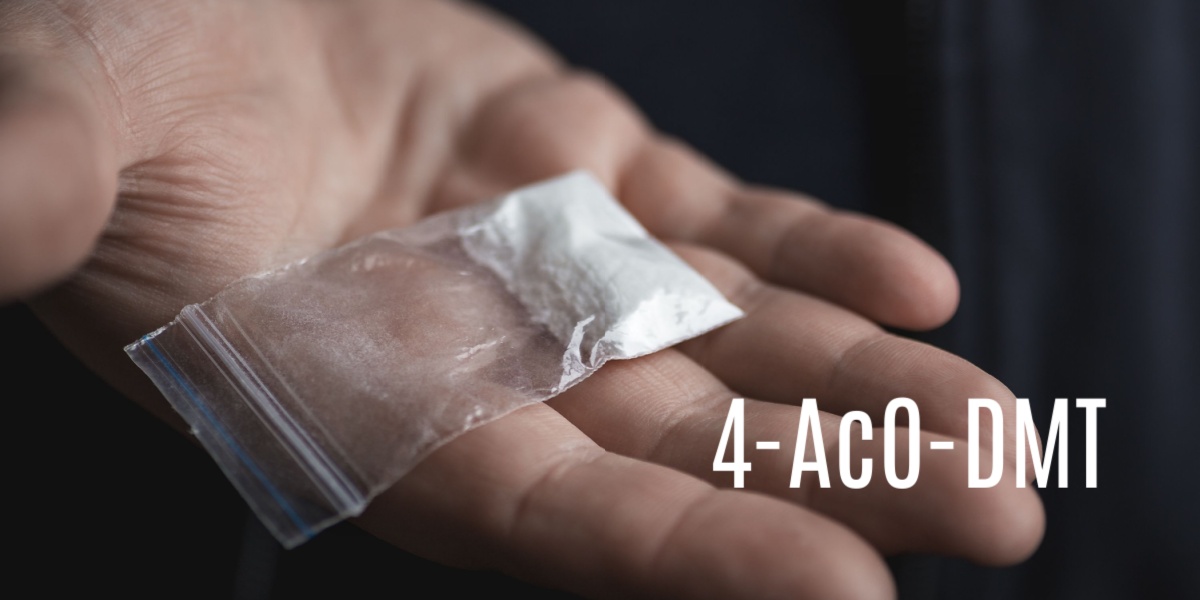4-AcO-DMT, also known as psilacetin, is a recently discovered synthetic psychedelic compound. It has a structure and properties similar to psilocybin, the active compound in “magic mushrooms” that exerts its hallucinogenic effects.
Due to the recent surge in research into the benefits of psychedelics for the treatment of mental health disorders like post-traumatic stress disorder (PTSD), depression, anxiety, and substance abuse disorders, 4-AcO-DMT emerges as a promising new potential treatment option.
Below, we’ll explore what 4-AcO-DMT is, its effects, and potential therapeutic applications.
- 4-AcO-DMT is a synthetic psychedelic compound closely related to psilocybin that produces similar hallucinogenic and introspective effects.
- Early research suggests it may hold therapeutic potential for conditions like depression, PTSD, and addiction by promoting neuroplasticity and emotional resilience.
- Although not explicitly illegal in the U.S., 4-AcO-DMT exists in a legal gray area and should be used cautiously due to potential psychological and physiological risks.

What is 4-AcO-DMT?
4-Acetoxy-N, N-dimethyltryptamine (4-AcO-DMT) is a synthetic psychedelic compound structurally related to psilocybin, the active ingredient in magic mushrooms. 4-AcO-DMT contains a 4-acetoxy group attached to the nitrogen atom of the tryptamine backbone, differentiating it from psilocybin, which has a 4-phosphoryloxy group.[1]
Although there are some structural differences, both compounds share a similar indole ring structure that is typical of tryptamines. Their similar structural composition is a potential reason scientists believe they exert similar effects.
Often referred to as "synthetic psilocybin" or "psilacetin," 4-AcO-DMT is a prodrug of psilocin. This means it converts into psilocin in the body as it is metabolized, and this is the same active metabolite into which psilocybin is converted when it is consumed.[2] This is why its effects are extremely similar to those of psilocybin-containing mushrooms.
4-AcO-DMT discovery and synthesis
4-AcO-DMT was first synthesized in the 1960s by Albert Hofmann and Franz Troxler while researching psychedelic tryptamines. Initially patented by Sandoz Pharmaceuticals, it never progressed to clinical development. However, it has gained popularity in psychedelic communities as a research chemical and alternative to naturally occurring psilocybin.[3]
Synthesizing 4-AcO-DMT in a laboratory setting typically involves acetylating psilocin, although scientists can also synthesize it from other tryptamine precursors. The process usually requires advanced knowledge of organic chemistry and access to specific reagents and equipment. The method can vary, but typically involves a series of chemical reactions introducing the acetoxy group into the tryptamine structure.
Effects and user experience
Users report that 4-AcO-DMT produces mind-altering effects similar to psilocybin, including heightened sensory perceptions, enhanced emotions, and cognitive shifts, such as profound introspection. Common experiences include:
- Visual distortions and hallucinations, ranging from enhanced colors to fractal images to geometric shapes.
- Enhanced creativity and introspection.
- Feelings of unity and connectedness.
- Euphoria or bliss.
- Heightened sense of touch (hyperesthesia).
- Changes in hearing and more emotional responses to music.
- Alterations in patterns of thinking, including nonlinear thinking, a sense of interconnectedness, or profound philosophical insights.
- Altered sense of time (may speed up, slow down, or become irrelevant).
Depending on dosage and individual metabolism, the effects can last between 4 and 8 hours.
Comparison with other psychedelics
While similar to psilocybin and DMT, 4-AcO-DMT has some unique characteristics:
- Psilocybin vs. 4-AcO-DMT: Both convert to psilocin in the body, but 4-AcO-DMT is believed to have a smoother onset of action and fewer gastrointestinal side effects.[4]
- DMT vs. 4-AcO-DMT: DMT is structurally similar to psilocybin and 4-AcO-DMT. It has a much shorter duration and is often smoked, leading to an intense but brief experience, whereas 4-AcO-DMT is active when taken orally and lasts much longer.[5]
Therapeutic potential
Research suggests that 4-AcO-DMT may hold significant therapeutic potential, particularly in treating mental health and substance use disorders.
Like psilocybin, 4-AcO-DMT is believed to promote neuroplasticity, meaning it can help rewire maladaptive thought patterns associated with depression, anxiety, and addiction.[6] Research suggests that its interaction with serotonin receptors, particularly 5-HT2A, plays a crucial role in modulating cognition, emotions, and behavior, which are often impaired in individuals with substance use disorders.[7]
Some evidence suggests that 4-AcO-DMT and similar psychedelics may have therapeutic uses—that they could potentially help people overcome addiction by easing withdrawal symptoms and breaking compulsive drug-seeking behaviors.[8] More research is needed to better understand and confirm potential benefits.
Psychedelic-assisted therapy with substances like 4-AcO-DMT has been associated with lasting improvements in emotional resilience and psychological flexibility—two factors critical in overcoming addiction. Studies also indicate the potential of 4-AcO-DMT to reduce symptoms of PTSD and major depressive disorder, conditions that frequently co-occur with addiction.[9]
While promising, more clinical trials are needed to fully understand the efficacy and safety of 4-AcO-DMT for therapeutic use. However, preliminary research indicates that, when administered in controlled settings, it could be a valuable tool in mental health and addiction treatment.
Potential risks and side effects
Because 4-AcO-DMT has not been extensively studied, its potential risks and side effects are not fully understood. But, like other psychedelics, 4-AcO-DMT carries similar risks, including:
- Psychological distress: Anxiety, paranoia, and confusion are particularly common, especially at higher doses.
- Nausea and dizziness: Users report nausea and dizziness as common early effects as the substance starts to cause physiologic effects.
- Increased heart rate and blood pressure: These can be risky for individuals with cardiovascular issues.
- Hallucinogen-Persisting Perception Disorder (HPPD): Some users report lingering visual disturbances after use.[10]
- Risk of triggering latent mental health conditions: Those with a history of schizophrenia or severe anxiety may experience exacerbated symptoms.
- Unpredictable experiences: Set and setting play crucial roles; an unfavorable environment may lead to a challenging experience.
Who should avoid it
Individuals with a history of the following conditions should avoid 4-AcO-DMT:
- Schizophrenia or psychotic disorders.
- Severe anxiety or panic disorders.
- Cardiovascular issues.
- A history of substance abuse should avoid 4-AcO-DMT, as it may exacerbate underlying conditions.
It is essential to consult with a medical provider about the safety of 4-AcO-DMT before use, as they can provide the most accurate information about its specific safety for you.
Is 4-AcO-DMT legal?
The DEA’s Controlled Substances List does not explicitly include 4-AcO-DMT as a controlled substance, meaning it is not expressly illegal under US federal law. However, because psilacetin is an analog of psilocin, law enforcement could penalize possession and sales under the Federal Analogue Act.[11] This means that while it is not specifically scheduled, it could still be treated as an illegal substance in certain circumstances.
Internationally, the legal status of 4-AcO-DMT varies. Some countries, such as the United Kingdom, have classified it as a controlled substance, making possession and distribution illegal. Other countries operate in legal gray areas where it is neither explicitly banned nor officially permitted. Always check local laws before purchasing or using 4-AcO-DMT.
Safety and harm reduction strategies
All drugs come with the risk of side effects and potential negative reactions. To reduce the risks of adverse events, it is important to keep the following harm reduction strategies in mind:
- Start low, go slow: Begin with a small dose to assess your specific sensitivity to 4-AcO-DMT.
- Use in a safe environment: A calm, familiar setting with a trusted individual or a licensed mental health provider can reduce the likelihood of adverse reactions and assist if things don’t go as planned.
- Avoid mixing with other substances: Combining 4-AcO-DMT with alcohol or other drugs can increase the risk of negative effects.
- Have a plan for a bad trip: Techniques like deep breathing and listening to calming music can help you navigate challenging experiences.
4-Aco-DMT dosage awareness
According to Keith Graves’ guide for law enforcement and drug testing agencies, common dosages of 4-AcO-DMT include:
- Threshold: 5–10 mg.
- Low: 10–20 mg.
- Moderate: 20–30 mg.
- High: 30–50 mg or more: Doses higher than 50 mg may result in overwhelming experiences and increased risks of adverse effects. Higher doses pose a greater risk of side effects.[12]
Most individuals will take 4-AcO-DMT orally as pills, capsules, or powders dissolved in liquids. It takes 20–40 minutes to take effect based on individual metabolism. The effects peak approximately 2–3 hours after ingestion and last 4–8 hours. Snorting 4-AcO-DMT has been anecdotally reported. This will lead to a much more intense experience with a shorter duration.

-person-thumbnail.jpg?v=1758880627)
-(1)-guide-detail.jpg?v=1722503074)

